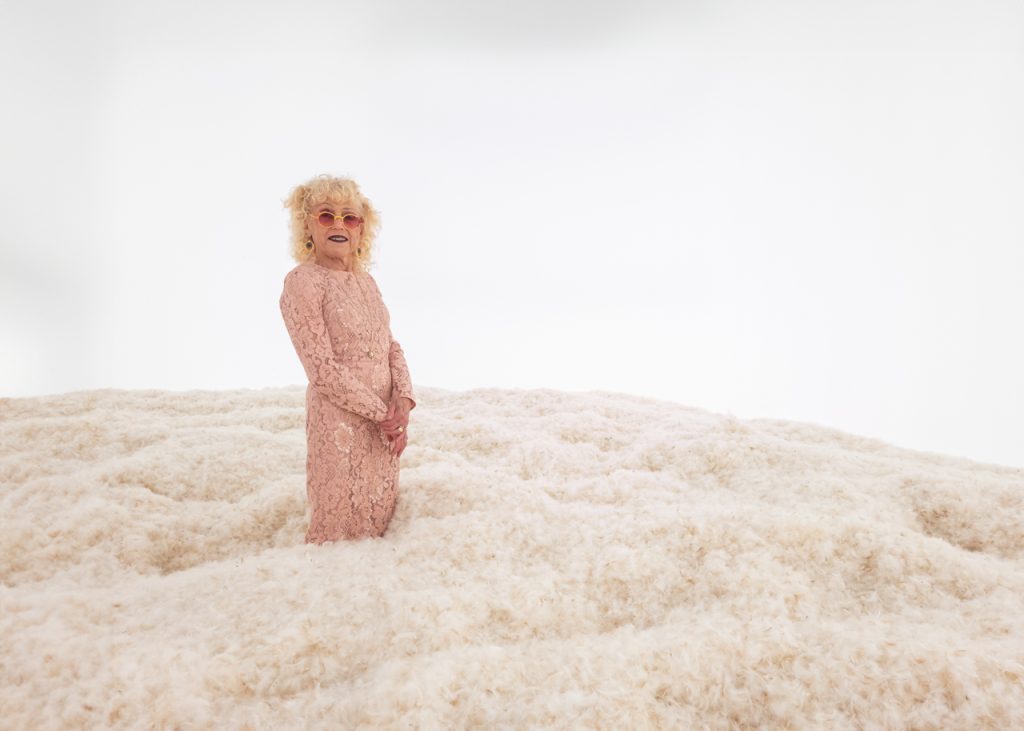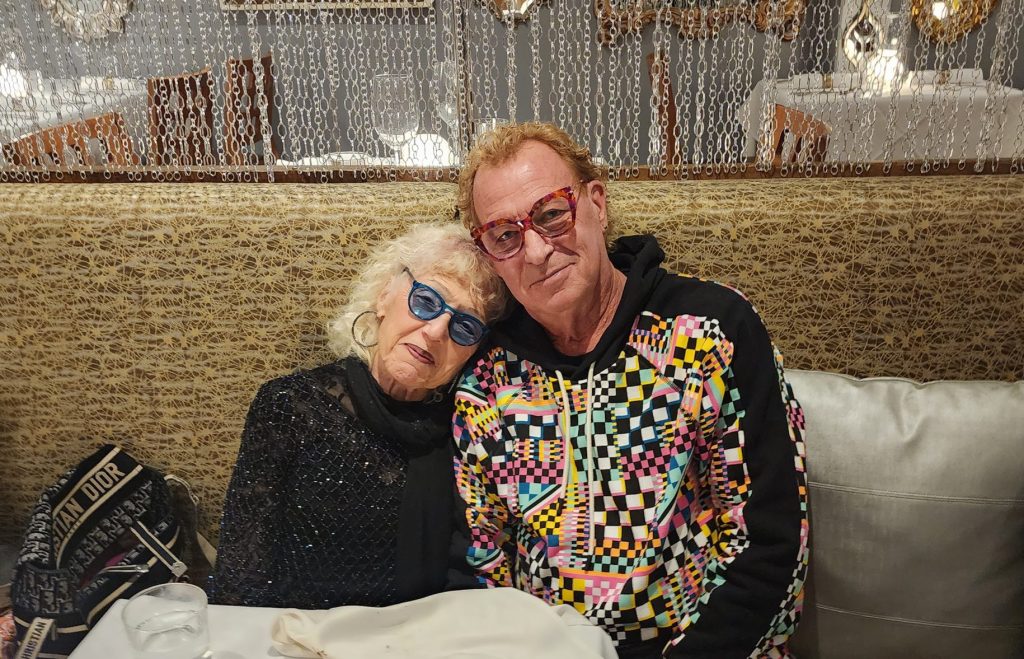

Massimiliano Gioni and Judy Chicago in “The City of Ladies” section of Judy Chicago: Herstory at the New Museum, New York City, 2023. © Judy Chicago/Artists Rights Society (ARS), New York; Photo © Donald Woodman/ARS, New York
In August 2022, I was contacted by Massimiliano Gioni, the chief curator at the New Museum in New York. I had known – and admired – him since 2015 when Donald and I went to Milan to see his groundbreaking exhibition “The Great Mother”. When I was doing research in the early 1980s for what would become the Birth Project – 85 works about birth and female creation that combine painting and needlework – the only images of birth I could find were from early cultures. This led me to conclude that there were NO images of birth in contemporary art, a supposition that Massimiliano’s show challenged. It turned out there were many images in 20th century art by both male and female artists which taught me that it has not just been women artists who have been erased but subject matter that the male-centered art world did not deem important (despite the fact that birth would seem to be a universal subject).
Installation view of Judy Chicago’s In the Beginning (1982) in the exhibition The Great Mother at the Nicola Trussardi Foundation in Milan, Italy, 2015. Photo © Donald Woodman/ARS, New York
Since that time, I’d followed Massimiliano’s career and when Donald and I would be in New York, one of the museums we often visited was the New Museum because they seemed to do really interesting shows. So I was completely thrilled when Massimiliano asked me what I would think of his doing an exhibition of my work in 2023 utilizing the entire museum. Moreover, he wanted to contextualize my work in a ‘show within a show’ that we titled “The City of Ladies” after Christine de Pisan’s 15th century book, which to my mind, marks the beginning of modern feminism.
Judy Chicago, detail of the Christine de Pisan Runner, from The Dinner Party, 1979. Elizabeth A. Sackler Center for Feminist Art, Collection of the Brooklyn Museum. ©️ Judy Chicago/Artists Rights Society (ARS), New York. Photo ©️ Donald Woodman/ARS, New York
Christine was the first female author to support herself with her pen. Widowed young with several children, she turned to writing to provide for her family and in the process, stimulated the first European discourse about the role of women. The City of Ladies is an effort to counter the increasingly misogynist writing of the Renaissance, in particular, a popular book titled La Romance de La Rose. In her book, Christine cited the achievements of 500 women, many of whom we had to re-research for The Dinner Party, my 1979 monumental symbolic history of women in Western Civilization, now permanently housed at the Brooklyn Museum. Thus is the ongoing plight of historic erasure with which women continue to contend.
By assembling the work of almost 90 women dating back to the 12th century abbess, Hildegarde von Bingen (who is represented in The Dinner Party), the “City of Ladies” allowed viewers to understand my work in a whole new way. Instead of placing it in the patriarchal art history that has been mistakenly presented as ‘universal’, it was finally seen as part of an alternative female-centered cultural paradigm; one that I had been working out of for decades. This decision turned out to be transformative in that it yielded the best writing about and reviews of the New Museum show than had ever occurred before.
(Left) Judy Chicago, Nadya Tolokonnikova and Hans Ulrich Obrist in conversation in front of the “What If Women Ruled the World” digital quilt at Serpentine North. (Right) “What if Women Ruled the World” participation booth inside Judy Chicago: Revelations at Serpentine North, 2024. Photos © Donald Woodman/ARS, New York
My collaborative project with Russian activist and Pussy Riot co-founder Nadya Tolokonnikova and produced in partnership with DMINTI, titled What if Women Ruled the World?, sparked a global conversation both virtually and physically about gender equality, addressing pressing global issues, and envisioning alternative futures. This project took my inspiring banners, which were created in collaboration with Maria Grazia Chiuri for the Dior Spring Summer 2020 Haute Couture show, as its source for a new revolutionary blockchain enabled call-and-response.
The stunning representation of the project, on display in Serpentine, features a portion of the digital quilt presented by DMINTI. Visitors to the gallery were encouraged to leave their own responses to the questions posed on my banners, leading to What if Women Ruled the World? being the most successful participatory project in Serpentine’s history.
(Left) Donald Woodman taking a photo of Judy Chicago in front of Serpentine North, London. Photo by Chris Bayley. (Top Right) Judy Chicago outside of Judy Chicago: Revelations at Serpentine North, London, 2024. (Bottom Right) Judy Chicago in front of In the Beginning (1982) in Judy Chicago: Revelations at Serpentine North, London, 2024. © Judy Chicago/Artists Rights Society (ARS), New York. Photo © Donald Woodman/ARS, New York
But that turned out to only be the beginning of a two year period that literally changed my life in that I finally achieved my lifelong goals; one of which was to contribute to an understanding of this female-centered cultural paradigm as an alternative to the white, male, patriarchal paradigm that most of us accept art history to be (with a few women, non-binary and artists of colors fit in here and there). In May, 2023, after several years delay because of COVID, “Revelations” opened at the Serpentine Gallery in London, curated by Hans Ulrich Obrist, assisted by Chris Bayley and Liz Stumpf. The show grew out of an unpublished manuscript by the same name from the 1970s that I never thought would see the light of day during my lifetime, but one of Hans Ulrich’s interests is artists’ unrealized projects and when he saw the manuscript, he said that it presaged my entire career, even predicting the climate crisis we are now facing and which I addressed in The End: A Meditation on Death and Extinction, (2012-2018).
The structure of the book provided the framework for the show which surveyed my 60 year body of art through drawing, and together, they provided insight into the underlying vision of my work which involves my efforts to achieve justice and equity for everyone who shares this planet, both human and non-human. The result was stupendous; the galleries were incredibly crowded, viewers often spent over an hour in the exhibit and there were apparently many tears shed, which demonstrated my belief in the power of art, a power that has been too often lost in the market-driven art world of today.
Then came LUMA Arles, an adaptation of the New Museum show that included my early Feather Room which was one of my first efforts to ‘soften’ or ‘feminize’ the world, a goal that also shaped my 50 plus Smoke Sculptures (or “Atmospheres”) which were surveyed at both Serpentine and LUMA. Plus, Maja Hoffmann, founder of LUMA, commissioned me to do a new Smoke Sculpture™. Unbeknownst to me when I conceived it, An Homage to Arles took place during the 150th celebration year of Impressionism. My idea was to turn the beautiful garden of the museum into an Impressionist painting, a tribute to my earliest influences. When I was a child studying art at the Art Institute of Chicago, after my classes, I would wander the light-filled galleries, spending hours in front of Monet’s water lilies and haystacks, Toulouse-Lautrec’s critiques of Parisian life; and Seurat’s Grand Jette (without really noticing the absence of women).

Judy Chicago inside of Feather Room (1966/2024) at LUMA Arles, 2024. © Judy Chicago/Artists Rights Society (ARS), New York. Photo © Donald Woodman/ARS, New York
The park at LUMA is highlighted by a Frank Gehry metal-clad tower that I incorporated into the piece which slowly filled the garden with multi-colored smoke, moving downwards towards a series of powder coated aluminum lilies in the pond, which provided the site for the finale as the centers of the lilies erupted with smoke and fireworks effects, a fitting celebration of my having achieved another of my goals which was, as I said, to make my underlying vision of justice and equity visible and understandable to the art world, which has – for the most part – tried to ignore, marginalize, erase or diminish what I’ve done. Not so my world-wide audience, one that repeatedly told me about the London and Arles exhibitions (which together, constituted my first retrospective in Europe), that these shows allowed them to SEE my work for the first time. Previously, they knew it only from photographs, books and classes devoted to my art.

Judy Chicago, An Homage to Arles (2024), staged by Pyro Spectaculars by Souza and Groupe F. Commissioned by LUMA Arles, Arles, France on the occasion of Judy Chicago’s first retrospective exhibition in Europe “Herstory” organized in collaboration with the New Museum, New York, NY. © Judy Chicago/Artists Rights Society (ARS), New York. Photos © Donald Woodman/ARS, New York
However, in order to achieve my goals, I lived a difficult life, one that deprived me of any financial security, (until recently) any property or a home of my own, required long hours in the studio and most of all, driving myself at a pace that has become unsustainable for a woman who just turned 85. But it was worth it because art – and my desire to make a contribution (a mandate handed down to me by my idealistic father who I lost when I was only thirteen) – has given my life meaning and hopefully can demonstrate that an individual can make a difference, something we have to remember in order to overcome the challenges we as human beings are now facing.
But this will be my last Chicago Gazette because I feel that I have completed the goals I set out for myself when I was young. Now I want to spend whatever time is left to me in my studio and with my wonderful husband, beloved cats and appreciating the miracle that is life.

Judy Chicago and Donald Woodman at dinner for New Year’s Eve, 2023.